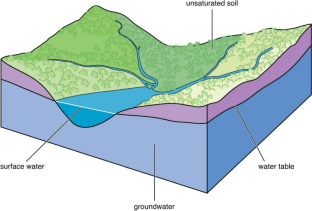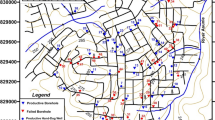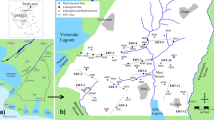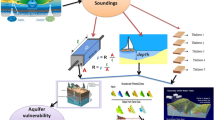Abstract
Geophysical exploration utilizing Vertical Electrical Resistivity (VES) techniques was employed to analyze aquifer characteristics and their impact on groundwater potential and vulnerability in the study area. The primary objective was to investigate the nature and groundwater-yielding potential of the area under scrutiny, comprehending the roles played by various aquifer parameters and their influence on the groundwater potential and effective characterization of hydrogeological units. To achieve the defined study objective, the electrical resistivity method was applied, employing Schlumberger electrode arrays with a maximum electrode separation (AB/2) of 50 m across 30 distinct locations for data acquisition. The acquired geoelectrical sections were subsequently utilized to generate contour maps for the aquifer parameters. The comparison of the diverse contour maps, depicting variations in hydrogeological parameters in multiple ways, proved to be insightful. The findings revealed that the overall trend of groundwater potential within the selected area is low, as indicated by Aquifer resistivity (17–678 Ωm), hydraulic conductivity 0.004–0.047 m/s), transmissivity (0.003–1.130 m2/day), and porosity (− 9.71 to 11.73). The groundwater potential Index map produce shows that the area is predominately made up of medium to low groundwater potential. About 56% of the area under investigation falls within the medium groundwater potential, followed by low (32%), High (10%), and very low (2%). The GWPI map created for the area can be instrumental in designing appropriate groundwater exploration and management strategies within the region, serving as a roadmap for the further expansion of research efforts.













Similar content being viewed by others
Data availability
The authors confirm that the data supporting the findings of this study are available within the article.
References
Abijith, D., Saravanan, S., Singh, L., Jennifer, J. J., Saranya, T., & Parthasarathy, K. S. S. (2020). GIS-based multi-criteria analysis for identification of potential groundwater recharge zones: A case study from Ponnaniyaru watershed, Tamil Nadu, India. Hydro Research, 3, 1–14. https://doi.org/10.1016/j.hydres.2020.02.002
Adeeko, T. O., Samson, D. O., & Umar, M. (2019). Geophysical survey of basement complex terrain using electrical resistivity method for groundwater potential. World News of Natural Sciences, 23, 154–165.
Adeyeye, O. A., Ikpokonte, E. A., & Arabi, S. A. (2019). GIS-based groundwater potential mapping within Dengi area, North Central Nigeria. The Egyptian Journal of Remote Sensing and Space Science, 22(2), 175–181. https://doi.org/10.1016/j.ejrs.2018.04.003
Adiat, K. A. N., Nawawi, M. N. M., & Abdullah, K. (2012). Assessing the accuracy of GIS-based elementary multi-criteria decision analysis as a spatial prediction tool-A case of predicting potential zones of sustainable groundwater resources. Journal of Hydrology, 440–441, 75–89. https://doi.org/10.1016/j.jhydrol.2012.03.028
Afolayan, J. F., Olorunfemi, M. O., & Afolabi, O. (2004). Geoelectric/electromagnetic VLF survey for groundwater development in a basement terrain: a case study. Ife Journal of Science, 6(1), 74–78. https://doi.org/10.4314/ijs.v6i1.32126
Akhmetov, Y. M., Assemov, K. M., & Shaytorov, V. N. (2020). Geophysical survey of the earthen dam using the electrical prospecting methods. Contributions to Geophysics and Geodesy, 50(2), 249–259. https://doi.org/10.31577/congeo.2020.50.2.4
Akinlalu, A. A., Adegbuyiro, A., Adiat, K. A. N., Akeredolu, B. E., & Lateef, W. Y. (2017). Application of multi-criteria decision analysis in prediction of groundwater resources potential: A case of Oke-ana, Ilesa area, southwestern, Nigeria. NRIAG Journal of Astronomy and Geophysics, 6, 182–200. https://doi.org/10.1016/j.nrjag.2017.03.001
Akintorinwa, O. J., Atitebi, M. O., & Akinlalu, A. A. (2020). Hydrogeophysical and aquifer vulnerability zonation of a typical basement complex terrain: A case study of Odode Idanre southwestern Nigeria. Heliyon, 6(8), e04549. https://doi.org/10.1016/j.heliyon.2020.e04549
Akintorinwa, O. J., & Olowolafe, T. S. (2013). Geoelectric evaluation of groundwater prospect within zion estate, Akure, southwest, Nigeria. International Journal of Water Resources and Environmental Engineering, 5(1), 12–28.
Alile, O. M., & Ujuambi, E. (2011). Geoelectric investigation of groundwater in Obaretin-Iyanorno locality, Edo State, Nigeria. Journal of Geology and Mining Research, 3(1), 13–20.
Ashaolu, E. D., & Adebayo, M. O. (2014). Characterizing Groundwater Level and Flow Pattern in a Shallow Overburden Aquifer: A Study of Ilara-Mokin and its Environs, Southwestern Nigeria. Momona Ethiopian Journal of Science, V6(2), 55–72.
Asiwaju-Bello, Y. A., & Ololade, J. O. (2013). Groundwater potential of Basement aquifers in part of Southwestern Nigeria. American International Journal of Contemporary Research, 3(3), 124–141.
Bayode, S., Ojo, J. S., & Olorunfemi, M. O. (2006). Geoelectric characterization of aquifer types in the basement complex terrain of parts of osun state, Nigeria. Global Journal of Pure and Applied Sciences, 12(3), 377–385.
Encyclopædia Britannica Retrieved 12 Dec 2023 from https://www.britannica.com/science/groundwater#/media/1/247019/54123
Chezgi, J., Pourghasemi, H. R., Naghibi, S. A., Moradi, H. R., & Kheirkhah Zarkesh, M. (2016). Assessment of a spatial multi-criteria evaluation to site selection underground dams in the Alborz Province, Iran. Geocarto International, 31(6), 628–646.
Dasho, O. A., Ariyibi, E. A., Akinluyi, F. O., et al. (2017). Application of satellite remote sensing to groundwater potential modeling in Ejigbo area, Southwestern Nigeria. Modeling Earth Systems and Environment, 3, 615–633. https://doi.org/10.1007/s40808-017-0322-z
Ekwe, A. C., Nnodu, I. N., Ugwumbah, K. I., & Onwuka, O. S. (2010). Estimation of aquifer hydraulic characteristics of low permeability formation from geosounding data: A case study of Oduma town, Enugu State. Online Journal of Earth Sciences, 4(1), 19–26.
Evans, U. F., George, N. J., Akpan, A. E., Obot, I. B., & Ibot, A. N. (2010). A study of superficial sediments and aquifers in parts of Uyo local government area, Akwa Ibom State, Southern Nigeria, using the electrical sounding method. European Journal of Chemistry, 7(3), 1018–1022. https://doi.org/10.1155/2010/975965
Ezema, O. K., Ibuot, J. C., & Obiora, D. N. (2020). Geophysical investigation of aquifer repositories in Ibagwa Aka, Enugu State, Nigeria, using electrical resistivity method, Groundwater for. Sustainable Development. https://doi.org/10.1016/j.gsd.2020.100458
Falae, P. O. (2014). Application of electrical resistivity in buildings foundation investigation in Ibese Southwestern Nigeria. Asia Pacific Journal of Energy and Environment, 1(2), 95–107.
Falae, P. O., Dash, R. K., Kanungo, D. P., & Chauhan, P. K. S. (2021). Interpretation on water seepage and degree of weathering in a landslide based on pre-and post-monsoon electrical resistivity tomography. Near Surface Geophysics, 19, 315–333. https://doi.org/10.1002/nsg.12142
Falae, P. O., Kanungo, D. P., Chauhan, P. K. S., & Dash, R. K. (2019). Electrical resistivity tomography (ERT) based subsurface characterisation of Pakhi Landslide, Garhwal Himalayas, India. Environmental Earth Sciences, 78, 430. https://doi.org/10.1007/s12665-019-8430-x
Falowo O.O, Amodu M.B. (2020) Groundwater Resource Assessment by Hydraulic Properties Determination for Sustainable Planning and Development in Central Part of Ondo State, Nigeria. JOWSET, (04), N° 02, 499–506.
George, N. J., Akpan, A. E., & Obot, I. B. (2010). Resistivity study of shallow aquifer in parts of southern Ukanafun Local government area, Akwa-Ibom State. European Journal of Chemistry, 7(3), 693.
George, N. J., Emah, J. B., & Ekong, U. N. (2015). Geophysical properties of hydrogeological units in parts of Niger Delta, southern Nigeria. Journal of African Earth Sciences, 105, 55–63. https://doi.org/10.1016/j.jafrearsci.2015.02.009
Gillefalk, M., Tetzlaff, D., Hinkelmann, R., Kuhlemann, L.-M., Smith, A., Meier, F., Maneta, M. P., & Soulsby, C. (2021). Quantifying the effects of urban green space on water partitioning and ages using an isotope-based ecohydrological model. Hydrology and Earth System Sciences, 25(3635–3652), 2021. https://doi.org/10.5194/hess-25-3635-2021
Heigold, P. C., Gilkeson, R. H., Cartwright, K., & Reed, P. C. (1979). Aquifer transmissivity from surficial electrical methods. Groundwater, 17(4), 338–345.
Helaly, A. S. (2017). Assessment of groundwater potentiality using geophysical techniques in Wadi Allaqi basin, Eastern Desert, Egypt: Case study. NRIAG Journal of Astronomy and Geophysics, 6(2), 408–421. https://doi.org/10.1016/j.nrjag.2017.09.003
Henriet, J. P. (1976). Direct application of DarZarrouk parameters in ground water surveys. Geophysical Prospecting, 24, 344–353.
Ibuot, J. C., Obiora, D. N., Ekpa, M. M., & Okoroh, D. O. (2017). Geoelectrohydraulic Investigation of the surficial aquifer units and corrosivity in parts of Uyo L. G. A., Akwa Ibom, Southern Nigeria. Journal of Applied Water Science, 7, 4705–4713. https://doi.org/10.1007/s13201-017-0632-3
Karandish, F., Nouri, H., & Brugnach, M. (2021). Agro-economic and socio-environmental assessments of food and virtual water trades of Iran. Science and Reports, 11, 15022. https://doi.org/10.1038/s41598-021-93928-9
Lamsal, I., Ghimire, S., & Acharya, K. K. (2020). Geological and Geophysical Study in Udheri Khola Area Nalgad Hydroelectric Project, Jajarkot District, Lesser Himalaya, Western Nepal. Bulletin of the Department of Geology., 22, 11–16. https://doi.org/10.3126/bdg.v22i0.33409
Marotz, G. (1968). Techische Grundlageneiner Wasswerspeicherung Immnaturlichen Utergrund Habilitationsschrift. Universitat Stuttgart.
Meying, A., Bidichael, W. W. E., Gouet, D., Ndougsa, M. T., Kuiate, K., & Ngoh, J. D. (2018). Hydrogeophysical investigation for groundwater resources from electrical resistivity tomography and self-potential data in the M´eiganga area, Adamawa, Cameroon. International Journal of Geophysics, 2018, 1–14. https://doi.org/10.1155/2018/2697585
Niwas, S., & Singhal, D. C. (1981). Estimation of aquifer transmissivity from dar zarrouk parameters in porous media. Journal of Hydrology, 50, 393–399.
Offodile, M.E. (2002). Groundwater Study and Development in Nigeria. Mecon Geology and Engineering Services Ltd., Jos. Nigeria, 453.
Ogungbemi, O. S., & Oladapo, M. I. (2014). Combined Use of Electromagnetic and Magnetic Survey for Hydrogeophysical Characterization of Ijapo Housing Estate. Akure, British Journal of Applied Science and Technology, 4(7), 1138–1148.
Oladapo, M. I., & Akintorinwa, O. J. (2007). Hydrogeophysical study of Ogbese south western Nigeria. Global Journal of Pure and Applied Sciences, 13(1), 55–61. https://doi.org/10.4314/gjpas.v13i1.16669
Oladapo, M. I., Mohammed, M. Z., Adeoye, O. O., & Adetola, B. A. (2004). Geo-electrical investigation of Ondo state housing corporation estate, Ijapo, Akure, southwestern Nigeria. Journal of Mining and Geology, 40(1), 41–48. https://doi.org/10.4314/jmg.v40i1.18807
Oladunjoye, M. A., Korode, I. A., & Adefehinti, A. (2019). Geoelectrical exploration for groundwater in crystalline basement rocks of Gbongudu community, Ibadan, southwestern Nigeria. Global Journal of Geological Sciences, 17, 25–43. https://doi.org/10.4314/gjgs.v17i1.3
Olorunfemi, M. O., & Fasuyi, S. A. (1993). Aquifer types and the geo-electric/hydrogeologic characteristics of part of the central basement terrain of Nigeria (Niger state). Journal of African Earth Sciences, 16(3), 309–317. https://doi.org/10.1016/0899-5362(93)90051-Q
Oni, T. E., Omosuyi, G. O., & Akinlalu, A. A. (2017). Groundwater vulnerability assessment using hydrogeologic and geoelectric layer susceptibility indexing at Igbara Oke, Southwestern Nigeria. NRIAG J. of Astronomy and Geophy., 6(2), 452–458. https://doi.org/10.1016/j.nrjag.2017.04.009
Oyeyemi, K. D., Joyce, A., Oluwatosin, J. R., Bastien, D., Modreck, G., Olaojo, A. A., Falae, P. O., & Mohamed, M. (2023). Geoelectrical characterization of coastal aquifers in Agbado-Ijaye, Lagos, Southwestern Nigeria. Implications for Groundwater Resources Sustainability. Sustainability, 15(4), 3538. https://doi.org/10.3390/su15043538
Rahaman, M. A. (1976). Review of the basement geology of Southwestern Nigeria. In C. A. Kogbe (Ed.), Geology of Nigeria. Elizabethan Publishing.
Snyder, S. (2019). Water in crisis: Spotlight India. Retrieved 01 Sep 2022 from https://thewaterproject.org/water-crisis/water-in-crisis-India
Taye, M. T., Dyer, E., Hirpa, F. A., & Charles, K. (2018). Climate change impact on water resources in the Awash Basin, Ethiopia. Water, 10(11), 1560. https://doi.org/10.3390/w10111560
Venkatesan, G., Pitchaikani, S., & Saravanan, S. (2019). Assessment of groundwater vulnerability using GIS and DRASTIC for upper Palar River basin, Tamil Nadu. Journal of the Geological Society of India, 94(4), 387–394. https://doi.org/10.1007/s12594-019-1326-2
Zhang, X., Zhang, J. Y., Ao, T. Q., Wang, X. J., Chen, T., & Wang, B. X. (2021). Evaluating the impacts of climate change on industrial water demand by sector. Climate Research, 84, 145–158. https://doi.org/10.3354/cr01661
Funding
The authors have not received funding for this project.
Author information
Authors and Affiliations
Corresponding author
Ethics declarations
Conflict of interest
The authors report there are no competing interests to declare.
Ethical approval
Not applicable.
Additional information
Publisher's Note
Springer Nature remains neutral with regard to jurisdictional claims in published maps and institutional affiliations.
Rights and permissions
Springer Nature or its licensor (e.g. a society or other partner) holds exclusive rights to this article under a publishing agreement with the author(s) or other rightsholder(s); author self-archiving of the accepted manuscript version of this article is solely governed by the terms of such publishing agreement and applicable law.
About this article
Cite this article
Ogundana, A.K., Falae, P.O. Groundwater potential modelling and aquifer zonation of a typical basement complex terrain: a case study. Environ Dev Sustain (2024). https://doi.org/10.1007/s10668-024-04940-8
Received:
Accepted:
Published:
DOI: https://doi.org/10.1007/s10668-024-04940-8




